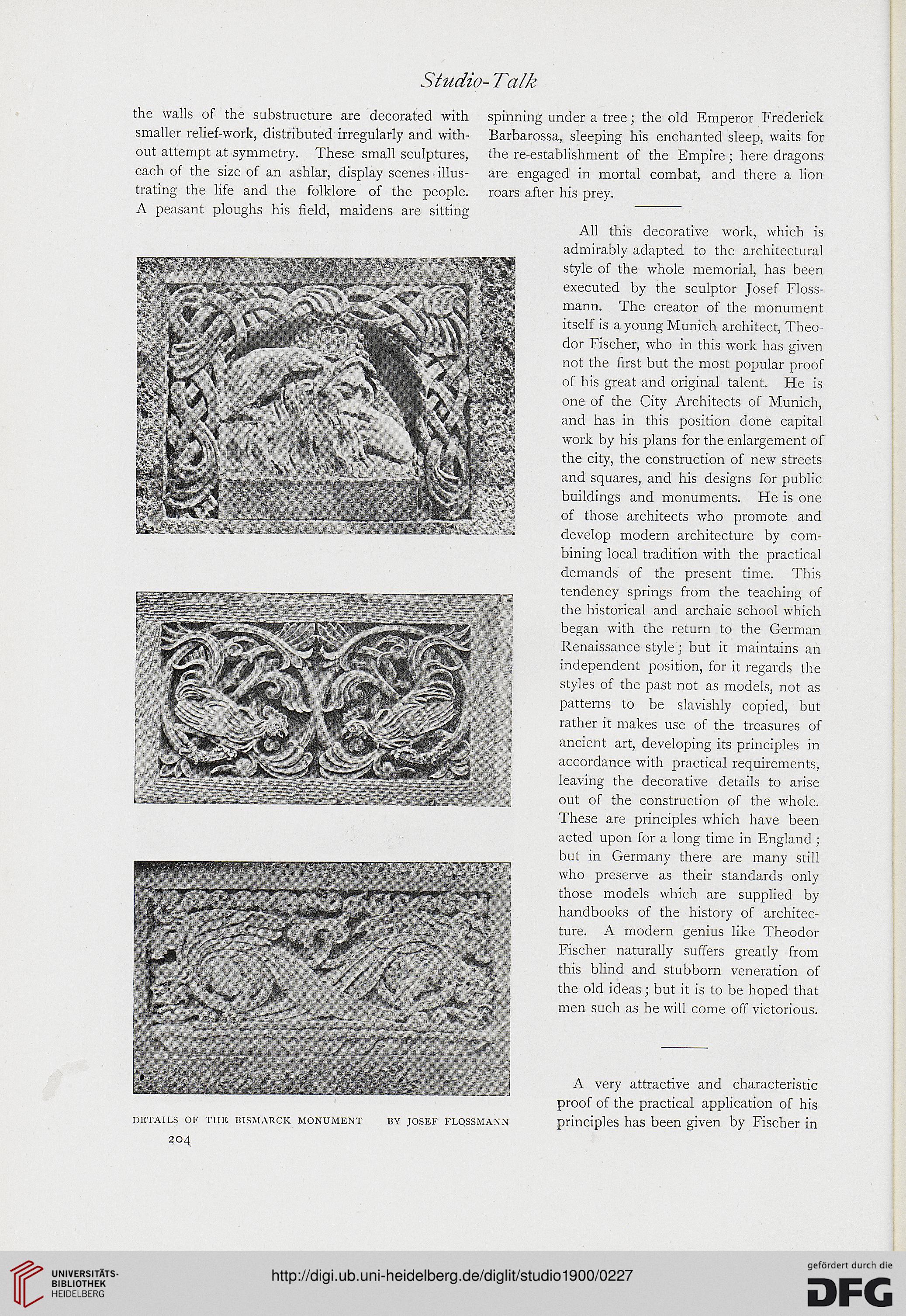Studio- Talk
the walls of the substructure are decorated with spinning under a tree; the old Emperor Frederick
smaller relief-work, distributed irregularly and with- Barbarossa, sleeping his enchanted sleep, waits for
out attempt at symmetry. These small sculptures, the re-establishment of the Empire; here dragons
each of the size of an ashlar, display scenes ■illus- are engaged in mortal combat, and there a lion
trating the life and the folklore of the people, roars after his prey.
A peasant ploughs his field, maidens are sitting
All this decorative work, which is
admirably adapted to the architectural
'^lpill|||^ style of the whole memorial, has been
■ J : maim. The creator of the monument
fi^^wl^^^^^life^VjSvil Mcjt' itself is a young Munich architect, Theo-
• V V,-'%^mMBP?:" ,'» s ' *^hhk^VJK^^Hg dor Fischer, who in this work has given
V* ^""VC^ , J" Sp1 - ^^HBl of his great and original talent. He is
one of the City Architects of Munich,
* . 'Hf" ^^v^T'*' \V ^^r^ ^jR^^^->^'-J?* and lias in this position done capital
&&|^{~ \ 1 y , | the (-ity, the <:onstru<:ti<)ii of new streets
a-" v « -v . /TjBBflBBK3^£--.:: develop modern architecture by com-
bining local tradition with the practical
demands of the present time. This
tendency springs from the teaching of
the historical and archaic school which
began with the return to the German
Renaissance style; but it maintains an
independent position, for it regards the
styles of the past not as models, not as
patterns to be slavishly copied, but
rather it makes use of the treasures of
ancient art, developing its principles in
accordance with practical requirements,
leaving the decorative details to arise
out of the construction of the whole.
These are principles which have been
acted upon for a long time in England ;
but in Germany there are many still
who preserve as their standards only
those models which are supplied by
handbooks of the history of architec-
ture. A modern genius like Theodor
Fischer naturally suffers greatly from
this blind and stubborn veneration of
the old ideas; but it is to be hoped that
men such as he will come off victorious.
DETAILS OF THE BISMARCK MONUMENT BY JOSEF FLOSSMAXN
204
A very attractive and characteristic
proof of the practical application of his
principles has been given by Fischer in
the walls of the substructure are decorated with spinning under a tree; the old Emperor Frederick
smaller relief-work, distributed irregularly and with- Barbarossa, sleeping his enchanted sleep, waits for
out attempt at symmetry. These small sculptures, the re-establishment of the Empire; here dragons
each of the size of an ashlar, display scenes ■illus- are engaged in mortal combat, and there a lion
trating the life and the folklore of the people, roars after his prey.
A peasant ploughs his field, maidens are sitting
All this decorative work, which is
admirably adapted to the architectural
'^lpill|||^ style of the whole memorial, has been
■ J : maim. The creator of the monument
fi^^wl^^^^^life^VjSvil Mcjt' itself is a young Munich architect, Theo-
• V V,-'%^mMBP?:" ,'» s ' *^hhk^VJK^^Hg dor Fischer, who in this work has given
V* ^""VC^ , J" Sp1 - ^^HBl of his great and original talent. He is
one of the City Architects of Munich,
* . 'Hf" ^^v^T'*' \V ^^r^ ^jR^^^->^'-J?* and lias in this position done capital
&&|^{~ \ 1 y , | the (-ity, the <:onstru<:ti<)ii of new streets
a-" v « -v . /TjBBflBBK3^£--.:: develop modern architecture by com-
bining local tradition with the practical
demands of the present time. This
tendency springs from the teaching of
the historical and archaic school which
began with the return to the German
Renaissance style; but it maintains an
independent position, for it regards the
styles of the past not as models, not as
patterns to be slavishly copied, but
rather it makes use of the treasures of
ancient art, developing its principles in
accordance with practical requirements,
leaving the decorative details to arise
out of the construction of the whole.
These are principles which have been
acted upon for a long time in England ;
but in Germany there are many still
who preserve as their standards only
those models which are supplied by
handbooks of the history of architec-
ture. A modern genius like Theodor
Fischer naturally suffers greatly from
this blind and stubborn veneration of
the old ideas; but it is to be hoped that
men such as he will come off victorious.
DETAILS OF THE BISMARCK MONUMENT BY JOSEF FLOSSMAXN
204
A very attractive and characteristic
proof of the practical application of his
principles has been given by Fischer in




